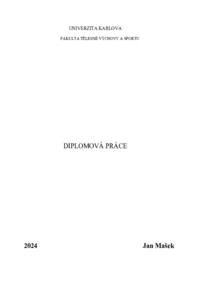Efekt unilaterálních a bilaterálních kontrolovaných excentrických kontrakcí na kondiční připravenost hráčů ledního hokeje U17 a U20
Effect of unilateral and bilteral controled eccentric contractions on physical conditions of U17 and U20 ice hockey players
diplomová práce (OBHÁJENO)

Zobrazit/
Trvalý odkaz
http://hdl.handle.net/20.500.11956/192566Identifikátory
SIS: 268271
Kolekce
- Kvalifikační práce [8928]
Autor
Vedoucí práce
Oponent práce
Jebavý, Radim
Fakulta / součást
Fakulta tělesné výchovy a sportu
Obor
Učitelství tělesné výchovy pro střední školy se specializací Trenérství se sportovní specializací
Katedra / ústav / klinika
Katedra sportovních her
Datum obhajoby
26. 8. 2024
Nakladatel
Univerzita Karlova, Fakulta tělesné výchovy a sportuJazyk
Čeština
Známka
Výborně
Klíčová slova (česky)
lední hokej, unilaterální zatížení, bilaterální zatížení, sílaKlíčová slova (anglicky)
ice hockey, unilateral loading, bilateral loading, strengthThe purpose of this masters thesis was to compare the effects of unilateral and bilateral strength training on performance measures in squat jump,countermovement jump, broad jump bilaterally, broad jump unilaterally on the right and left leg, Illinois agility test, wingate test, 1500 meter run, 3x200 meter run, and Y-Balance test. The research sample consisted of 30 ice hockey players falling into the U17 and U20 categories, playing in regional U17 and U20 leagues. The players were randomly assigned into two groups performing either only bilateral-based or unilateral-based strength training. The total duration of the training intervention was six weeks for both group, with training sessions performed twice a week. Thus, the subjects completed a total of 12 trainings. All subject were tested before and after the training intervention and the data were analyzed using ANOVA analysis followed by Tukey post-hoc test. Normality of the data was determined using the Kolmogorov-Smirnov test. ANOVA analysis showed statistically significant improvements in performance measures for the squat jump (F1, 28 = 8.22, p = 0.008), countermovement (CMJ) jump (F1, 28 = 4.82, p = 0.037), Illinois agility test on left side (F1, 26 = 4.93, p = 0.035) and right side (F1, 26 =36.88, p < 0. 001), 1500-meter run (F1, 22 =...
The purpose of this masters thesis was to compare the effects of unilateral and bilateral strength training on performance measures in squat jump,countermovement jump, broad jump bilaterally, broad jump unilaterally on the right and left leg, Illinois agility test, wingate test, 1500 meter run, 3x200 meter run, and Y-Balance test. The research sample consisted of 30 ice hockey players falling into the U17 and U20 categories, playing in regional U17 and U20 leagues. The players were randomly assigned into two groups performing either only bilateral-based or unilateral-based strength training. The total duration of the training intervention was six weeks for both group, with training sessions performed twice a week. Thus, the subjects completed a total of 12 trainings. All subject were tested before and after the training intervention and the data were analyzed using ANOVA analysis followed by Tukey post-hoc test. Normality of the data was determined using the Kolmogorov-Smirnov test. ANOVA analysis showed statistically significant improvements in performance measures for the squat jump (F1, 28 = 8.22, p = 0.008), countermovement (CMJ) jump (F1, 28 = 4.82, p = 0.037), Illinois agility test on left side (F1, 26 = 4.93, p = 0.035) and right side (F1, 26 =36.88, p < 0. 001), 1500-meter run (F1, 22 =...
